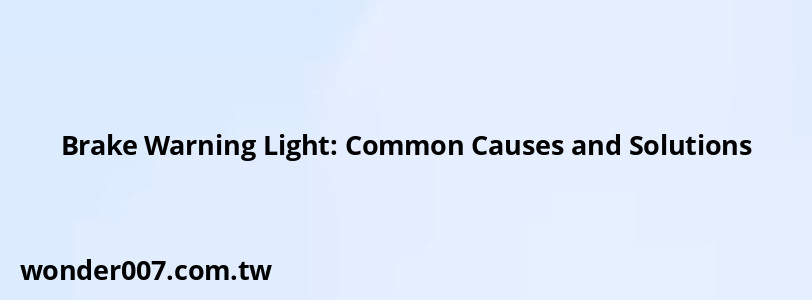Brake Warning Light: Common Causes and Solutions

The brake warning light on your vehicle's dashboard is a crucial indicator of your braking system's health. When this light illuminates, it signals that there may be a problem requiring immediate attention. This article aims to inform vehicle owners about the potential reasons for the brake warning light activation and the necessary steps to address these issues.
Understanding the Brake Warning Light
The brake warning light can appear as a red or amber light on your dashboard, often represented by an exclamation mark within a circle. Its primary function is to alert you to various issues in your braking system. Ignoring this warning can lead to severe safety risks, so it's essential to understand what might cause it to illuminate.
Common Causes of the Brake Warning Light
There are several reasons why the brake warning light may come on:
- Low Brake Fluid: This is one of the most frequent causes. The brake fluid level can drop due to leaks or evaporation, leading to insufficient hydraulic pressure for effective braking.
- Engaged Parking Brake: If the parking brake is not fully released, it can trigger the warning light. Ensure that the parking brake is disengaged before driving.
- Worn Brake Pads: Many vehicles have sensors that detect when brake pads are worn down and need replacement. If these pads are excessively worn, they can cause damage to other components.
- ABS Malfunction: A failure in the Anti-lock Braking System (ABS) can also activate the brake warning light. This system prevents wheel lock-up during hard braking and requires immediate inspection if faulty.
- Faulty Sensors: The sensors that monitor fluid levels and brake conditions can fail, leading to false alarms or failure to alert you about genuine issues.
- Hydraulic System Issues: Problems within the hydraulic circuits, such as leaks or failures, can affect braking efficiency and illuminate the warning light.
What to Do When the Brake Warning Light Comes On
Upon noticing the brake warning light, follow these steps:
1. Pull Over Safely: As soon as it is safe, reduce speed and pull over to a secure location.
2. Check Parking Brake: Ensure that the parking brake is completely disengaged.
3. Inspect Brake Fluid Level: Open the hood and check the brake fluid reservoir. If fluid levels are low, top them up with the appropriate type of brake fluid.
4. Examine for Leaks: Look under your vehicle for any signs of leaking fluid which may indicate a more serious issue.
5. Assess Brake Pads: If comfortable, check the thickness of your brake pads for wear and tear.
6. Consult a Professional: If you cannot identify or resolve the issue, take your vehicle to a qualified mechanic for a thorough inspection.
FAQs About Brake Warning Light
- What should I do if my brake warning light stays on?
If it remains illuminated after checking all potential causes, seek professional assistance immediately. - Can I drive with the brake warning light on?
It is not advisable to drive with this light on as it indicates potential braking issues that could compromise safety. - How often should I check my brake fluid?
Regularly check your brake fluid level at least once a month or before long trips.
Understanding these common causes and solutions will help you respond effectively when your vehicle's brake warning light comes on, ensuring both your safety and that of others on the road.
Related Posts
-
2015 Chrysler 200: Essential Guide to Transmission and Park Brake
29-01-2025 • 189 views -
Engine Coolant Over Temperature: Causes and Solutions
26-01-2025 • 238 views -
1994 Ford Ranger Transmission Issues: Common Problems
30-01-2025 • 243 views -
Mini Cooper Warning Lights: Essential Guide for Drivers
26-01-2025 • 290 views -
Steering Wheel Jerks: Causes and Solutions for Bumpy Rides
29-01-2025 • 211 views
Latest Posts
-
How To Turn Off Paddle Shifters Mercedes
01-02-2025 • 387 views -
Power Steering Fluid Leak On Passenger Side
01-02-2025 • 461 views -
Are O2 Sensors Covered Under Warranty
01-02-2025 • 378 views -
2015 Chevy Traverse AC Recharge Port Location
01-02-2025 • 418 views -
Rear Brake Caliper Piston Won't Compress
01-02-2025 • 361 views
Popular Posts
-
Toyota Hiace: Fuel Efficiency Insights for 2025
26-01-2025 • 646 views -
EPC Light: Understanding Causes and Solutions
26-01-2025 • 1065 views -
Hino Warning Lights: Understanding Dashboard Alerts
26-01-2025 • 794 views -
Power Steering and ABS Light On: Causes and Solutions
27-01-2025 • 649 views -
V12 Engine Costs: What You Need to Know
26-01-2025 • 688 views
